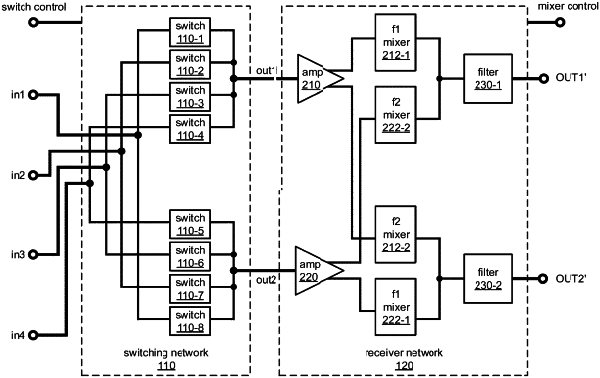| CPC H04B 1/04 (2013.01) [H01Q 3/247 (2013.01); H01Q 3/2617 (2013.01); H04B 1/30 (2013.01); H04B 2001/0408 (2013.01); H04B 2001/307 (2013.01)] | 11 Claims |

|
1. A circuit for wireless signal reception comprising a switching network having:
M switches;
N inputs connected to the M switches and configured to connect to N antenna sub-arrays;
K outputs connected to the M switches and configured to connect to K amplifiers, where M is greater than N and K and M, N, and K are integers greater than 1, and wherein the M switches are configured to route a signal from a selected input of the N inputs to a selected output of the K outputs; and
a receiver network having:
a first amplifier having a first input to receive a first wireless communication signal from a first of the K outputs;
a first mixer or synthesizer connected to a first output of the first amplifier;
a second mixer or synthesizer connected to a second output of the first amplifier;
a second amplifier having a second input to receive a second wireless communication signal from a second of the K outputs;
a third mixer or synthesizer connected to a third output of the second amplifier; and
a fourth mixer or synthesizer connected to a fourth output of the second amplifier, wherein an output of the first mixer or synthesizer and an output of the third mixer or synthesizer are connected to a first node and an output of the second mixer or synthesizer and an output of the fourth mixer or synthesizer are connected to a second node,
wherein the first mixer or synthesizer and the fourth mixer or synthesizer are configured to operate with a first local oscillator frequency and the second mixer or synthesizer and the third mixer or synthesizer are configured to operate with a second local oscillator frequency different from the first local oscillator frequency.
|